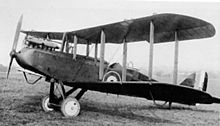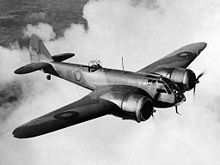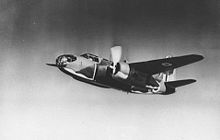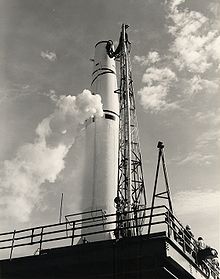- No. 107 Squadron RAF
-
No. 107 Squadron RAF Active 8 Oct 1917 - 30 Jun 1919
6 Aug 1936 - 4 Oct 1948
22 Jul 1959 - 10 Jul 1963Country  United Kingdom
United KingdomBranch  Royal Air Force
Royal Air ForceNickname Lowestoft's 'own' Squadron[1] Motto French: Nous y serons
(Translation: "We shall be there")[1]Commanders Notable
commandersBasil Embry Insignia Squadron Badge heraldry A double-headed eagle displayed gorged with a collar of Fleur de Lys.[1][2]
The double-headed eagle is one of the supporters from the armorial bearings of Salisbury, in which district the squadron was formed. The collar of fleur-de-lys was introduced in reference to service in France in the First World War during a period when the unit was attached to the French Army. The motto is said to have been derived from the squadron magazine produced in the First World War and entitled The Objective ('107' Squadron Always Gets There).[1][3]Squadron Codes 107 (Aug 1936 - Oct 1938)
BZ (Oct 1938 - Sep 1939)[4][5]
OM (Sep 1939 - Oct 1948)[6][7]No. 107 Squadron RAF was a bomber unit in the RAF in both World War I and World War II and during the Cold war was operational on Thor Intermediate Range Ballistic Missiles.
Contents
History
Formation and World War I
Though already formed at Catterick, Salisbury as a day bomber unit on 8 October 1917[2][8]), no. 107 squadron wasn't equipped with aircraft till 15 May 1918, when it received Airco DH.9s, which it took to the Western Front on 3 June of that year. The squadron became at first part of the 13th wing of the 3rd brigade, working up to operational status. Thereafter it was transferred to the 51st wing of the 9th brigade and it began operations from Drionville.[9] Its main targets were enemy airfields, base areas and communication lines,[2] which it continued to attack until the Armistice. The squadron's most successful raid was made on Saponay on 21 July 1918, where a large ammunition dump was hit. From the squadron's airfield, 20 miles away at Chailly, the reflection of the explosions and fire could be seen going on all the evening and throughout the night.[10] Another notable raid was that made on the Aulnoye railway station and junction on 1 October 1918.[1][11] Returning to Hounslow Heath Aerodrome in March 1919, it disbanded there on 30 June of that same year.[1][2][8][12]
Reformation and World War II
No. 107 squadron was reformed at RAF Andover on 10 August 1936[8] as a light bomber squadron, equipped with Hawker Hinds. These were replaced by Blenheim Mk.Is from August 1938 which gave way in their turn to Blenheim Mk.IVs in May 1939. It was with four of this aircraft that no. 107 took part in the RAF's first bombing raid of the war against enemy ships in the German port of Wilhelmshaven on 4 September 1939, the day after war was declared on Germany. The raid was no success: of the four aircraft despatched only one returned - and with its bomb load still intact as it hadn't been able to locate the enemy.[1] The first British Prisoner of war in World War II was Sergeant George Booth, a navigator with 107 Squadron. He was captured when his Bristol Blenheim was shot down over the German coast on that 4 September 1939.[13] In April 1940 the squadron carried out attacks on German forces engaged in the invasion of Norway and after the invasion of France and the Low Countries in May 1940 began attacking enemy columns and communications.[2] Following the Dunkirk evacuation the squadron became engaged with attacking invasion barges and shipping concentrations in the Channel ports. In one of these attacks the new Commanding Officer, Wing Commander Basil Embry was shot down. He had taken over the squadron shortly after the disastrous first war mission in September 1939 and had taught the squadron the need for a tight formation for mutual defence which served the squadron time and again.[14] The adventurous story of his escape from captivity eventually reached book form.[15]
In Coastal Command
Between 3 March 1941 and till May 1941, the squadron was on loan to RAF Coastal Command and stationed at RAF Leuchars. Its duties while in Coastal Command were various: shipping strikes, convoy duties, coastal patrols, submarine searches and attacks on enemy airfields and harbours. These were quite hazardous as the squadron lost two COs during these operations, Wing Commander Cameron in April and Wing Commander Birch on 4 May 1941.[16]
To Malta
On return to RAF Bomber Command the squadron took up its low-level daylight raids again until August of that year, when the aircraft of the unit and their pilots -the air detachment of the squadron- were sent to Malta. From there anti-shipping missions were carried out along the Axis' north-south convoy routes, around the Italian coast, Sicily, and along the North African coast. However, after the Italian and German airforces strengthened the air defence of Sicily in December, 1941, and began round-the-clock bombing of the Malta airfields, the air detachment was withdrawn and disbanded at Luqa on 12 January 1942.[2] Losses among the squadron had been so heavy - 90% of all original and replacement crews were killed in action during the Malta operations[17] - that at one time the squadron was commanded by a sergeant, I.G. Broom.[18] It was not the last time this man was in command of a RAF unit, he ended his career as Air Marshal Sir Ivor Broom.[19]
Bostons and Mosquitoes
In the meantime the rest of the squadron, forming the ground echelon, had remained at Great Massingham, Norfolk and on 5 January 1942, it received Douglas Boston trainers and new aircrews, and began converting them onto this aircraft.[20][21] The squadron began flying daylight operations again in March 1942[22] and these were continued until February 1944, when the squadron received Mosquito Mk.VIs and switched to night intruder operations instead with these.[2] In November the squadron moved onto the continent, flying from Cambrai and later from Melsbroek. The squadron continued to fly in the night intruder role to the end of war, when it ook up the duty of training in the light bomber role.[23] Remaining in Germany as part of the British Air Forces of Occupation (BAFO) after the war, it was disbanded on 4 October 1948 at Wahn by being renumbered to No. 11 Squadron RAF.[1][23] (Though some sources claim 15 September 1948)[2][8]
On Thor missiles
When the Thor Intermediate Range Ballistic Missile were employed in the UK each operating missile squadron was originally meant to control three sites. 107 squadron so started out in September 1958 by being the 'C' flight of the first RAF Thor missile unit, No. 77 Squadron RAF. The flight was stationed at RAF Tuddenham. By June 1959 the flights had reached squadron strength and in September 1959 it was decided that such sites should carry their own identities, 'C' flight of 77 squadron was thus redesignated to No. 107(SM) Squadron RAF, to be effective from 22 July 1959,[24] making no. 107 squadron one of the twenty RAF squadrons that reached operational status using the Thor missile. This new incarnation of no. 107 squadron did not last long though. The upcoming ICBM missiles soon made the Intermediate Range Ballistic Missile obsolete, and in 1962 the Minister of Defence announced the phase-out of the Thor missiles.[25] The squadron therefore disbanded once again, at Tuddenham on 10 July 1963.[2][8]
Aircraft operated
Aircraft operated by no. 107 Squadron RAF, data from[2][8][26][27] From To Aircraft Variant May 1918 Jun 1919 Airco DH.9 Sep 1936 Sep 1938 Hawker Hind Mk.I Aug 1938 May 1939 Bristol Blenheim Mk.I May 1939 Jan 1942 Bristol Blenheim Mk.IV Jan 1942 Feb 1944 Douglas Boston Mks.III, IIIa Feb 1944 Sep 1948 De Havilland Mosquito Mk.VIb Jul 1959 Jul 1963 Thor Intermediate Range Ballistic Missile SM.75 Commanding officers
Officers commanding no. 107 Squadron RAF, data from[28] From To Name May 1918 September 1918 Major J.R. Howett September 1918 June 1919 Major H. Gordon Dean August 1936 October 1937 F/Lt. E.A. Healy October 1937 June 1939 S/Ldr. V.Q. Blackden June 1939 August 1939 S/Ldr. Bear August 1939 September 1939 W/Cdr. E.F. Haylock September 1939 May 1940 W/Cdr. B.E. Embry May 1940 September 1940 W/Cdr. L.R. Stokes September 1940 January 1941 W/Cdr. J.W. Duggan January 1941 April 1941 W/Cdr. W.E. Cameron April 1941 May 1941 W/Cdr. Birch May 1941 July 1941 W/Cdr. Petley July 1941 July 1941 W/Cdr. Booth July 1941 October 1941 W/Cdr. Harte October 1941 December 1941 Sgt. I.G. Broom (acting) December 1941 January 1942 W/Cdr. Dunlevie January 1942 September 1942 W/Cdr. L.H. Lynn September 1942 December 1942 W/Cdr. D.H. Dutton December 1942 February 1943 W/Cdr. A.C.P. Carver February 1943 April 1943 W/Cdr. I.J. Spencer April 1943 October 1943 W/Cdr. R.G. England November 1943 July 1944 W/Cdr. M.E. Pollard July 1944 April 1945 W/Cdr. W.J. Scott April 1945 July 1946 W/Cdr. W.C. Maher August 1946 December 1946 W/Cdr. D.P. Hanafin December 1946 June 1947 W/Cdr. B. Kemp June 1947 October 1948 W/Cdr. Banning Lover July 1959 January 1961 S/Ldr. R.P. Flood January 1961 July 1963 S/Ldr. H.G. Norton See also
- List of UK Thor missile bases
References
Notes
- ^ a b c d e f g h Moyes 1976, p. 150.
- ^ a b c d e f g h i j Halley 1988, p. 181.
- ^ Northway 1963, p. 13.
- ^ Bowyer and Rawlings 1979, p. 13.
- ^ Flintham and Thomas 2003, p. 49.
- ^ Bowyer and Rawlings 1979, p. 80.
- ^ Flintham and Thomas 2003, p. 96.
- ^ a b c d e f Jefford 2001, p. 58.
- ^ Northway 1963, p. 1.
- ^ Northway 1963, p. 3.
- ^ Squadron history on RAF.mod.uk
- ^ Northway 1963, p. 7.
- ^ Northway 1963, p. 22.
- ^ Northway 1963, p. 26.
- ^ Richardson and Embry 1950
- ^ Northway 1963, p. 31.
- ^ Gillman 1976, p. v.
- ^ Northway 1963, p. 37.
- ^ Air of Authority - A History of RAF Organisation
- ^ Squadron history on RAFWeb
- ^ Northway 1963, p. 39.
- ^ Northway 1963, p. 40.
- ^ a b Northway 1963, p. 72.
- ^ Northway 1963, pp. 77–81.
- ^ Northway 1963, p. 89.
- ^ Northway 1963, p. 97.
- ^ Moyes 1976, p. 151.
- ^ Northway 1963, pp. 95–96.
Bibliography
- Bowyer, Michael J.F. and John D.R. Rawlings. Squadron Codes, 1937-56. Cambridge, UK: Patrick Stephens Ltd., 1979. ISBN 0-85059-364-6.
- Flintham, Vic and Andrew Thomas. Combat Codes: A full explanation and listing of British, Commonwealth and Allied air force unit codes since 1938. Shrewsbury, Shropshire, UK: Airlife Publishing Ltd., 2003. ISBN 1-84037-281-8.
- Gillman, Sgt. R.E., DFC, DFM. The Shiphunters. London, John Murray, 1976. ISBN 0-7197-3299-x.
- Halley, James J. The Squadrons of the Royal Air Force & Commonwealth 1918-1988. Tonbridge, Kent, UK: Air Britain (Historians) Ltd., 1988. ISBN 0-85130-164-9.
- Jefford, Wing Commander C.G., MBE, BA, RAF(Retd.). RAF Squadrons, a Comprehensive record of the Movement and Equipment of all RAF Squadrons and their Antecedents since 1912. Shrewsbury, Shropshire, UK: Airlife Publishing, 1988 (second edition 2001). ISBN 1-85310-053-6.
- Moyes, Philip J.R. Bomber Squadrons of the RAF and their Aircraft. London: Macdonald and Jane's (Publishers) Ltd., 2nd edition 1976. ISBN 0-354-01027-1.
- Northway, B.S. (ed). A History of 107 Squadron. Tuddenham, UK: No. 107 Squadron RAF, 1963.
- Richardson, Anthony and Embry, Sir Basil. Wingless Victory: The Story of Sir Basil Embry's Escape from Occupied France in the Summer of 1940. Aylesbury, UK: Shire Publications, 1950 (reprinted 1973). ISBN 0-70570-008-9.
Related content
External links
- Official RAF webpage for 107 sqn.
- Squadron histories for nos. 106-110 sqn of RafWebs "Air of Authority"
Currently active Inactive 1 · 4 · 10 · 13 · 20 · 21 · 23 · 25 · 26 · 34 · 35 · 36 · 37 · 38 · 40 · 42 · 43 · 44 · 46 · 48 · 49 · 50 · 52 · 53 · 55 · 58 · 59 · 61 · 62 · 63 · 64 · 65 · 66 · 67 · 68 · 69 · 70 · 71 · 73 · 74 · 75 · 76 · 77 · 79 · 80 · 81 · 82 · 83 · 85 · 86 · 87 · 88 · 89 · 90 · 91 · 92 · 93 · 94 · 95 · 96 · 97 · 98 · 102 · 103 · 104 · 105 · 106 · 107 · 108 · 109 · 110 · 111 · 112 · 113 · 114 · 115 · 116 · 117 · 118 · 119 · 120 · 121 · 122 · 123 · 124 · 125 · 126 · 127 · 128 · 129 · 130 · 131 · 132 · 133 · 134 · 135 · 136 · 137 · 138 · 139 · 140 · 141 · 142 · 143 · 144 · 145 · 146 · 147 · 148 · 149 · 150 · 151 · 152 · 153 · 154 · 155 · 156 · 157 · 158 · 159 · 160 · 161 · 162 · 163 · 164 · 165 · 166 · 167 · 168 · 169 · 170 · 171 · 172 · 173 · 174 · 175 · 176 · 177 · 178 · 179 · 180 · 181 · 182 · 183 · 184 · 185 · 186 · 187 · 188 · 189 · 190 · 191 · 192 · 193 · 194 · 195 · 196 · 197 · 198 · 199 · 200 · 201 · 204 · 205 · 209 · 210 · 211 · 212 · 213 · 214 · 215 · 217 · 218 · 219 · 220 · 221 · 222 · 223 · 224 · 225 · 226 · 227 · 228 · 229 · 231 · 232 · 233 · 234 · 235 · 236 · 237 · 238 · 239 · 240 · 241 · 242 · 243 · 244 · 245 · 246 · 247 · 248 · 249 · 250 · 251 · 252 · 253 · 254 · 255 · 256 · 257 · 258 · 259 · 260 · 261 · 262 · 263 · 264 · 265 · 266 · 267 · 268 · 269 · 270 · 271 · 272 · 273 · 274 · 275 · 276 · 277 · 278 · 279 · 280 · 281 · 282 · 283 · 284 · 285 · 286 · 287 · 288 · 289 · 290 · 291 · 292 · 293 · 294 · 295 · 296 · 297 · 298 · 299 · 353 · 354 · 355 · 356 · 357 · 358 · 360 · 361 · 510 · 511 · 512 · 513 · 514 · 515 · 516 · 517 · 518 · 519 · 520 · 521 · 524 · 525 · 526 · 527 · 528 · 529 · 530 · 531 · 532 · 533 · 534 · 535 · 536 · 537 · 538 · 539 · 540 · 541 · 542 · 543 · 544 · 547 · 548 · 549 · 550 · 567 · 569 · 570 · 571 · 575 · 576 · 577 · 578 · 582 · 586 · 587 · 595 · 597 · 598 · 618 · 619 · 620 · 621 · 622 · 623 · 624 · 625 · 626 · 627 · 628 · 629 · 630 · 631 · 635 · 639 · 640 · 644 · 650 · 651 · 652 · 653 · 654 · 655 · 656 · 657 · 658 · 659 · 660 · 661 · 662 · 663 · 664 · 665 · 666 · 667 · 668 · 669 · 670 · 671 · 672 · 673 · 679 · 680 · 681 · 682 · 683 · 684 · 691 · 692 · 695
Australian Flying Corps (AFC) units attached
to the RAF during the First World WarCommonwealth air force units attached to
the RAF during the Second World War.Squadrons formed from non-Commonwealth
personnel during the Second World WarArgentineBelgian349 · 350CzechoslovakDutchFrenchGreek335 · 336NorwegianYugoslavRoyal Auxiliary Air Force Special ReserveAuxiliary Air ForceFleet Air Arm of the RAF (1924–1939) Royal Air Force portal Formations and units Commands · Groups · Stations · Wings · Aircraft squadrons · Aircraft flights · Conversion units · Regiment squadrons

Branches and components RAF Regiment · RAF Chaplains Branch · RAF Intelligence · RAF Legal Branch · Princess Mary's RAF Nursing Service · RAF Police · Search and Rescue Force · Mountain Rescue Service
Reserve forces Associated civil organizations Air Training Corps · RAF Association · RAF Centre of Aviation Medicine
Equipment List of RAF aircraft · List of RAF missiles
Personnel Symbols and uniform History · Timeline · Future Categories:- Royal Air Force aircraft squadrons
- Military units and formations established in 1917
- Military units and formations of the Royal Air Force in World War I
- Military units and formations of the Royal Air Force in World War II
- 1917 establishments in the United Kingdom
Wikimedia Foundation. 2010.




